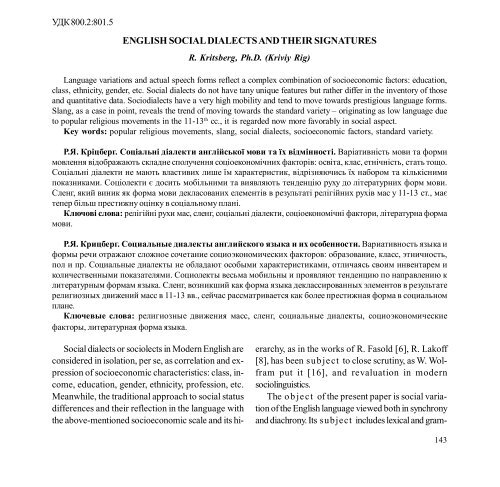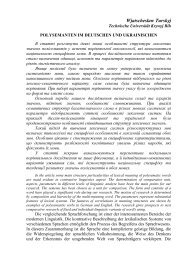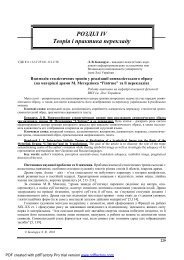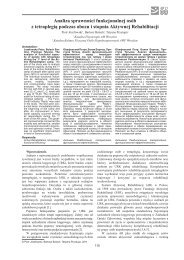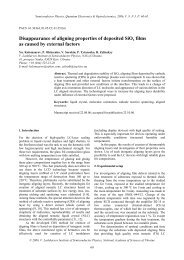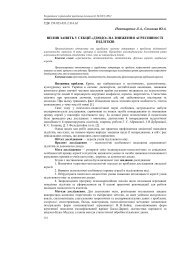ENGLISH SOCIAL DIALECTS AND THEIR SIGNATURES
ENGLISH SOCIAL DIALECTS AND THEIR SIGNATURES
ENGLISH SOCIAL DIALECTS AND THEIR SIGNATURES
You also want an ePaper? Increase the reach of your titles
YUMPU automatically turns print PDFs into web optimized ePapers that Google loves.
УДК 800.2:801.5<br />
<strong>ENGLISH</strong> <strong>SOCIAL</strong> <strong>DIALECTS</strong> <strong>AND</strong> <strong>THEIR</strong> <strong>SIGNATURES</strong><br />
R. Kritsberg, Ph.D. (Kriviy Rig)<br />
Language variations and actual speech forms reflect a complex combination of socioeconomic factors: education,<br />
class, ethnicity, gender, etc. Social dialects do not have tany unique features but rather differ in the inventory of those<br />
and quantitative data. Sociodialects have a very high mobility and tend to move towards prestigious language forms.<br />
Slang, as a case in point, reveals the trend of moving towards the standard variety – originating as low language due<br />
to popular religious movements in the 11-13 th cc., it is regarded now more favorably in social aspect.<br />
Key words: popular religious movements, slang, social dialects, socioeconomic factors, standard variety.<br />
Р.Я. Кріцберг. Соціальні діалекти англійської мови та їх відмінності. Варіативність мови та форми<br />
мовлення відображають складне сполучення соціоекономічних факторів: освіта, клас, етнічність, стать тощо.<br />
Соціальні діалекти не мають властивих лише їм характеристик, відрізняючись їх набором та кількісними<br />
показниками. Соціолекти є досить мобільними та виявляють тенденцію руху до літературних форм мови.<br />
Сленг, який виник як форма мови декласованих елементів в результаті релігійних рухів мас у 11-13 ст., має<br />
тепер більш престижну оцінку в соціальному плані.<br />
Ключові слова: релігійні рухи мас, сленг, соціальні діалекти, соціоекономічні фактори, літературна форма<br />
мови.<br />
Р.Я. Крицберг. Социальные диалекты английского языка и их особенности. Вариативность языка и<br />
формы речи отражают сложное сочетание социоэкономических факторов: образование, класс, этничность,<br />
пол и пр. Социальные диалекты не обладают особыми характеристиками, отличаясь своим инвентарем и<br />
количественными показателями. Социолекты весьма мобильны и проявляют тенденцию по направлению к<br />
литературным формам языка. Сленг, возникший как форма языка деклассированных элементов в результате<br />
религиозных движений масс в 11-13 вв., сейчас рассматривается как более престижная форма в социальном<br />
плане.<br />
Ключевые слова: религиозные движения масс, сленг, социальные диалекты, социоэкономические<br />
факторы, литературная форма языка.<br />
Social dialects or sociolects in Modern English are<br />
considered in isolation, per se, as correlation and expression<br />
of socioeconomic characteristics: class, income,<br />
education, gender, ethnicity, profession, etc.<br />
Meanwhile, the traditional approach to social status<br />
differences and their reflection in the language with<br />
the above-mentioned socioeconomic scale and its hi-<br />
erarchy, as in the works of R. Fasold [6], R. Lakoff<br />
[8], has been subject to close scrutiny, as W. Wolfram<br />
put it [16], and revaluation in modern<br />
sociolinguistics.<br />
The object of the present paper is social variation<br />
of the English language viewed both in synchrony<br />
and diachrony. Its subject includes lexical and gram-<br />
143
Вісник ХНУ № 896 2010<br />
matical markers of socially disfavored language forms.<br />
The aim of this paper is to highlight a topical approach<br />
to considering social dialects of English as result of<br />
interaction of various socioeconomic factors. Markers<br />
of social dialects in lexis, morphology, and syntax,<br />
along with literary specimens of G. Chaucer [3], W.<br />
Langland [9], and W. Shakespeare [12] serve as material<br />
for this paper. Its significance lies in elaboration<br />
on various constituents that bring about the complexity<br />
of language variation.<br />
Indeed, social, regional and other variations of language<br />
are closely connected due to interaction of territorial,<br />
socioeconomic, gender, ethnicaland other etc<br />
factors. A good case on point is Norman French that<br />
from a pure territorial dialect of Old French had changed<br />
into a social dialect, Anglo-French, since the Norman<br />
Conquest through the end of the 13 th c., spoken by the<br />
court and nobles. Anglo-French underwent double influence<br />
of French and English, according to M.A.<br />
Borodina [1, p. 82-89]. It goes without saying that there<br />
were some changes of the word-forms in the process<br />
of the transplant, mainly due to dynamic English stress<br />
[ibid], e.g. aphaeresis (deservir > servir “to serve”),<br />
syncope (vesteur > vesture), assimilation (prevost ><br />
provost). Or, changes conditioned by two-fold influence,<br />
English and French, as diphthong ‘au’ before<br />
nasal consonants: acrodaunt “according”, plesaunt<br />
“pleasant”, repentaunt “repentant”, aqueentaunce<br />
“acquaintance”, etc. Still, the double nature of Anglo-<br />
French along with its shift of status from regional to<br />
social dialect cannot be denied.<br />
Another example of that kind is social-ethnic dialect<br />
African American Vernacular English (AAVE).<br />
Despite numerous migration of American black population,<br />
as the mass exodus to the North in the beginning<br />
of 20 th c., still, its sociolinguistic roots and “catchment<br />
area” are in the South.<br />
The territorial dialect of Pittsburgh, Pennsylvania,<br />
although traditionally referred to the Midland group,<br />
still has signatures of its own and retained its own<br />
speech patterns: diphthong ‘ow’ is pronounced as ‘ah’,<br />
‘l’ is dropped at the end of the word (radial sounds as<br />
radio, downtown as dahntahn), cot coincides with<br />
caught, don – with down, to redd up is “to clean up”,<br />
yinz is “y’all”. Pittsburgh dialect has high prestige<br />
144<br />
among all social groups in this area. It means that a<br />
local variety cuts across social positions of community<br />
of its speakers.<br />
In dialects of the American South, the following<br />
speech patterns are idiosyncratic: y’all = you all, to<br />
be fixing to = to be going to, and so called ‘double<br />
modals’ – might would, might would, might can,<br />
might should, may can, may will to minimize the use<br />
of the utterance. According to The American Heritage<br />
Dictionary [14, p. 113], such modes of speech<br />
“carry little if any social stigma within the South<br />
and are used by speakers of all social classes and<br />
educational levels – even in formal instances”. Their<br />
use is due probably to the fact that first settlers in this<br />
area were Scottish-Irish whose language is rich in such<br />
double modals [ibid]. In this case, it is a clear-cut connection<br />
among regional, social, and ethnical factors.<br />
As for the sociolinguistic prospect, social factors and<br />
sociolects as indicators of those should, as well, be considered<br />
in complex along with regional dialects. Ethnical<br />
dialect Jewish English, e.g., is closely associated with<br />
the New York City English (ethnic and urban factors),<br />
AAEV is a marker of a certain, low social status of its<br />
speakers (social and ethnic factors), and dialect Chicano<br />
English spoken by young descendents from Latin<br />
America is used among the urban population of the<br />
American Southwest (regional, urban, and ethnic factors),<br />
according to W. Wolfram [16, p. 165].<br />
There have been numerous attempts to specify the<br />
unique features of some dialects that were not successful,<br />
so far. R. Fasold, for example, suggested 8 signatures<br />
of AAVE, among those are: devoicing of voiced<br />
stops in stressed syllables, as /t?k/ for tag; third person<br />
–s absence in Present Tense; plural –s absence of noun<br />
plural; copula and auxiliary absence; the use of habitual<br />
be, etc. [6, p. 171]. Still, those features are current in<br />
other American and British dialects, and differences<br />
among those, as A.D. Shveytser put it, are rather quantitative<br />
than qualitative, with dialect differences not in<br />
their unique features but in their sets [2, p. 158].<br />
R. Lakoff, in her turn, singles out 10 characteristics<br />
of women speech. Among them are: ‘hedges’ that<br />
mitigate the effect of the utterance (a bit, to seem,<br />
don’t you, perhaps) and ‘boosters’ that make the statement<br />
stronger (really), rising (question) intonation in
statements, reduced or ‘weak’ directives (would you<br />
mind…?), etc. [8]. Still, some research, especially the<br />
recent one on the comparative material of English and<br />
Farsi languages [10], has not supported so called ‘female<br />
deficit theory’, the lower social status of women<br />
in a society: the language signatures of gender differences<br />
have not been found [ibid]. It does not mean<br />
that such differences are non-existing. D. Tannen, e.g.,<br />
suggests six ‘dimensions’ where male and female<br />
speeches differ: status/support, independence/intimacy,<br />
advice/understanding, information/emotion, orders/suggestions,<br />
conflict/compromise [13]. However, the language<br />
characteristics of those ‘dimensions’ are not<br />
elaborated on. Moreover, one can argue that those<br />
‘dimensions’ are rather conditioned by more important<br />
social factors, such as class, education level, etc.<br />
One more problem in sociolinguistics deals with the<br />
relation of vernacular dialects, both social and regional,<br />
to standard or socially prestigious varieties. Often, the<br />
rating of standardness is a subjective characteristic,<br />
dependent on regional, areal, and social backgrounds.<br />
Thus, for British English (BE) speakers American Standard<br />
English (AE) with its signatures in phonology,<br />
lexis, spelling, and grammar will definitely appear as<br />
‘non-standard’, and vice versa. E.g., bomb in BE<br />
means “success” while in AE it is “failure”. Even within<br />
the same regional variety, frames of reference may<br />
differ. Boston English, for example, is a non-mainstream<br />
dialect in AE (‘pahk the cah in Hahvard yahd’<br />
= ‘park the car in Harvard yard’), while in Massachusetts,<br />
it enjoys high social prestige. Speakers of<br />
American South are regarded as non-standard in<br />
American North, etc.<br />
Social dialects are extremely mobile, both in respect<br />
of each other and their standard variety. Thus, Estuary<br />
English, regional dialect of south-eastern England<br />
(Kent, Essex, Sussex, Surrey), has recently made tremendous<br />
impact on BBC English. As D. Crystal put it<br />
“Estuary English may therefore be the result of a<br />
confluence of two tends: an up-market movement<br />
of originally Cockney speakers, and a down-market<br />
trend towards ‘ordinary’ (as opposed to ‘posh’)<br />
speech by the middle class” [4, p. 327].<br />
Slang in the English language is a good case in point.<br />
Its problems, especially the vagueness of this umbrella<br />
ЛІНГВІСТИКА ТЕКСТУ І СОЦІОЛІНГВІСТИКА<br />
term, its attributes, relations among American, British,<br />
Australian, etc. slang, and those between general and<br />
special slang, etc. have been the subject of heated debates<br />
in linguistics. One issue stands apart in particular:<br />
the position of slang in relation to standard languages.<br />
One can compare the definitions of slang diachronically.<br />
In 1756, Oxford English Dictionary (OED) defined slang<br />
as “the special vocabulary used by any set of persons<br />
of a low or disreputable character, language<br />
of low and vulgar type” [15, p. 1787]. In 1801, another<br />
sense appeared with the edge blunted: “the special<br />
vocabulary or phraseology of a particular calling<br />
or profession; the cant or jargon of certain class<br />
or period” to end in 1818 as “language of a highly<br />
colloquial type, considered as below the level of standard<br />
educated speech” [ibid]. It is worth mentioning<br />
that modern sources often avoid reference to standard<br />
speech, as Oxford American Dictionary: “words,<br />
phrases, or particular meaning of these that are used<br />
very informally for vividness, or novelty, or to avoid being<br />
conventional” [11, p. 639]. Despite all surrounding<br />
controversy, it is clear that general slang is on its way<br />
towards Informal Standard English, especially in the<br />
USA, positioning itself on the frontier between standard<br />
and non-standard vocabulary.<br />
From this standpoint, it is important to shed light on<br />
historical development of slang. Religious beliefs in the<br />
medieval Europe from 11 th to the 13 th centuries were<br />
going through the big changes. The spirit of Christian<br />
cut across people’s social rank, degree and position in<br />
society: town-people and villagers, nobility and peasants,<br />
intellectuals and common priests. The idea that<br />
true faith’s vestiges were not pompous monastic rituals<br />
but humble and virtuous life in poverty took root<br />
among believers: “seized by the spirit, laymen and<br />
monks turned itinerant preachers proclaiming a<br />
Christ who came not with a sword and power but<br />
in poverty” [7, p. 198]. The Mendicant Orders and<br />
small groups of “poor men of Christ” spread like a<br />
wildfire. Popular religious movements ranged from left<br />
to right, from orthodox to heretical reflected disenchantment<br />
with the hypocrisy of the Roman church, on the<br />
one hand, on the other, expressed the nascent Renaissance<br />
awareness of one’s inward freedom, liberation<br />
and human values.<br />
145
Вісник ХНУ № 896 2010<br />
Europe in that time abounded with itinerant preachers,<br />
wandering monks, self-proclaimed prophets and<br />
hermits, foot-loose and fancy-free vagabonds of all<br />
kinds who took a leap on earning their living: “the driving<br />
force behind all these manifestations of religious<br />
fervour was the urge to lead the apostolic<br />
146<br />
life in imitation of the poverty and humility of<br />
Christ” [ibid, p. 203]. The idea for people who hit the<br />
road was to earn their daily bread by preaching, begging<br />
or laboring. W. Langland in his ‘The Vision of<br />
Piers Plowman” [9] gave a visible picture of that “begging”<br />
time:<br />
“Bidderes and beggeres faste aboute yede<br />
[Til] hire bely and hire bagge [were] bredful ycrammed;<br />
Faiteden for hire foode, foughten at the ale.<br />
In glotonye, God woot, go thei to bedde,<br />
And risen with ribaudie, tho Roberdes knaves;<br />
Sleep and sory sleuthe seweth hem evere.<br />
Pilgrymes and palmers plighten hem togidere<br />
To seken Seint Jame and seintes in Rome;<br />
Wenten forth in hire wey with many wise tales,<br />
And hadden leve to lyen al hire lif after.<br />
I seigh somme that seiden thei hadde ysought seintes:<br />
To ech a tale that thei tolde hire tonge was tempred to lye…” (Prologue. 40-51).<br />
“Beggars both professional and amateur went around fast<br />
Till their bellies and bags were filled;<br />
Begged falsely for their food and fought at the ale-house.<br />
God knows that they go to bed in gluttony,<br />
And rise with obscenities, those vagabonds;<br />
Sleep and wretched sloth follow them everywhere.<br />
Pilgrims and palmers pledged together<br />
To visit St James and saints in Rome;<br />
And they went forth their way with many wise speeches,<br />
And had permission to tell lies for the rest of their live.<br />
I saw some who said they had visited saints:<br />
But each tale they told with their tongue was tuned to lie…”<br />
As it is seen, this preaching and migration had degenerated<br />
quickly into free lifestyle and promoted coming<br />
into life new vernacular forms of speech that might<br />
have laid foundation for slang.<br />
The very words beggar, to beg presumably have<br />
their source in popular religious movement of Beguines.<br />
The first Beguinage, a feminine community was<br />
founded at Liege about 1170-1180 dedicated to spiritual<br />
life along weaving, spinning and similar crafts [15,<br />
p. 234]. Then, the movements spread to Germany,<br />
France, and other countries, and a male branch was<br />
formed. Beguines were persecuted as heretics and had<br />
to seek the protection of Dominicans. The obscure<br />
original senses in the words bribe, bribery reflect the<br />
begging practice of that and other vagabond order.<br />
According to the OED, the semantic development in<br />
the word bribe presumably would appear in the following<br />
way: from the Old French sense “a piece of<br />
bread given to a beggar” to English “alms”, “living upon<br />
alms”, “professional begging”, “theft, plunder’, “blackmail,<br />
baksheesh exacted by authorities who abused their<br />
positions” and finally “gift itself” [ibid, p. 173]. Bribe<br />
and derivative words often appear in G. Chaucer’s<br />
works in the last sense:
ЛІНГВІСТИКА ТЕКСТУ І СОЦІОЛІНГВІСТИКА<br />
“This somnour…<br />
Feynynge a cause, for he wolde brybe”. (The Friar’s Tale. 1376. 1378).<br />
“This summoner…<br />
Inventing a charge, because he wanted to rob her”.<br />
“Certeyn he knew of briberyes mo<br />
Than possible is to telle in yeres two”. (ibid. 1367-1368).<br />
“Certainly he knew more methods of stealing money<br />
Than it is possible to tell in two years”.<br />
Slang and colloquialisms are abundantly used in the<br />
works of G. Chaucer and W. Shakespeare. G. Chaucer<br />
uses a lot of low expletives, as: by my croun (The<br />
Reeve’s Tale. 4041) “by my crown”, “By armes,<br />
and by blood and bones” (The Miller’s Prologue.<br />
3125) “By Christ’s arms”(ibid), etc.<br />
The G. Chaucer’s works are full of colloquial words<br />
and phrases, e.g. Stynt thy clappe (ibid. 3144) “stop<br />
your brawl”, popelote (The Miller’s Tale, 3254)<br />
“young girl”, blowe the bukkes horn (ibid. 3387) “to<br />
blow the buck’s horn=to work without reward”, clom!<br />
(ibid. 3639) “mum, be quiet!”, he hadde moore tow<br />
on his distaf (ibid. 3774) “he had other business on<br />
hand”, jape (ibid. 3841) “joke”, swyve (ibid. 3850)<br />
“to copulate”, daf “sissy”, cokenay “fool” (The<br />
Reeve’s Tale. 4208), etc.<br />
A considerable number of items that refer to parts<br />
of human body are found in W. Shakespeare works,<br />
as mazard (jocular, arch.) “the head” (Hamlet. V.i.94)<br />
from the original sense “drinking bowl, cup”; pate “the<br />
head, the skull” (from possible association with plate<br />
or shining, bald head) (ibid. 114); sconce (jocular,<br />
slang, arch.) “the head” (possible derivation from homonym<br />
“a kind of candle with a screen to protect the<br />
light from the wind”) (ibid. 108);<br />
A lot of lexical items of that kind describe negative<br />
characteristics of human beings, as it is proper to slang<br />
and colloquial vocabulary: sheep and calves “fools,<br />
gullible people” (ibid 124), knave, as a general term<br />
of opprobrium, is very current in the material (ibid<br />
147), along with rogue (ibid. 196), one of the cant<br />
words introduced in the 16 th c., according to OED [15,<br />
p. 1606] that originally referred to a beggar or vagabond<br />
There are numerous set phrases, as not a jot “not<br />
in the least” (ibid. 121), to gall one’s kibe “to irritate,<br />
vex, annoys” (from the original sense of to gall “chafing<br />
of a yoke”), as in the following:<br />
“…the age is grown so picked that the toe of the peasant<br />
comes so near the heel of the courtier, he galls his kibe”. (ibid 150-2).<br />
Intimate sphere of human relationship in G. Chaucer<br />
and W. Shakespeare’s works is reflected quite significantly.<br />
The examples below show the whole gamut of<br />
“Ham. I could interpret between you and your love,<br />
if I could see the puppets [=genitals] dallying.<br />
Oph. You are keen [= insolent], my lord, you are keen.<br />
Ham. It would cost you a groaning to take off my edge.<br />
Oph. Still better, and worse”. (ibid. III. ii. 260-265).<br />
The “underground bawdy” [5, p. 106] or double<br />
entendre was conspicuous for the Renaissance period,<br />
at a time when a liberated language was challenging<br />
old taboos although facing new repressions from the<br />
the writers’ ingenuity when it comes to one of the most<br />
powerful human drives. Thus, Hamlet while observing<br />
the play speaks to Ophelia:<br />
Puritans and Quakers. In the following dialog between<br />
Hamlet and Ophelia (Hamlet. II. ii. 120-129), the<br />
prince’s pun has an improper sense:<br />
147
Вісник ХНУ № 896 2010<br />
148<br />
“Ham. Lady shall I lie in your lap?<br />
Oph. No, my lord.<br />
Ham. I mean, my head upon your lap?<br />
Oph. Ay, my lord.<br />
Ham. Do you think I meant country matters?<br />
Oph. I think nothing, my lord.<br />
Ham. Tha’s a fair thought to lie between maids’ legs.<br />
Oph. What is, my lord?<br />
Ham. Nothing”.<br />
In another scene (IV. v.) mad Ophelia peppers her speech with rather indecent oaths:<br />
“By Gis [Jesus] and by Saint Charity,<br />
Alack, and fie for shame!<br />
Young men will do’t, if they come to ‘t;<br />
By Cock they are to blame.<br />
Quoth she, before you tumbled [have sex] me…” (59-63).<br />
Nonny was another word, which had indecent allusion<br />
(presumably to women’s genitals), as in Hamlet<br />
(IV. v. 164.).<br />
“Of crow flowers, nettles, daisies, and long purples,<br />
That liberal shepherds give a grosser name,<br />
But our cold maids do dead men’s fingers call them”.<br />
One more lexical layer that is associaled with professional<br />
spheres is prolific in the works of two writers.<br />
E.g.: come in, tailor; here you may roast your goose<br />
=”a tailor’s smoothing iron” from the resemblance of<br />
its handle to the goose neck (Macbeth. II. iii. 17);<br />
“What should be spoken Here where our fate is fate,<br />
hid in the auger-hole” (a carpenter’s tool) (ibid. II.<br />
iii. 128-129); “…The source of this our watch and<br />
the chief head Of this post-haste and romage in the<br />
land”. (Hamlet. I. i. 106-107). According to OED<br />
Another reference to licentiousness is made by<br />
Queen in IV. vii. 169-172:<br />
[15, p. 1398], the origin of this item came from the old<br />
directions on letters “Haste, post, haste!, where post<br />
stands for “courier”; Hamlet calls the Ghost of his father<br />
“A worthy pioner!” (ibid v. 163) comparing his<br />
moving beneath the earth to the work of a miner, digger.<br />
Another old saying of that kind is cut and long tail<br />
“all sorts of people (from the literal sense “horses and<br />
dogs with long and cut tails”)” is used by W.<br />
Shakespeare in the modern meaning come rain or<br />
sunshine, come hell or high water, etc. E.g.:<br />
“Shal. He will maintain you like a gentlewoman.<br />
Slen. Ay, that I will, come cut or long-tail, under the degree of a squire”. (ibid. III. iv. 45-48).<br />
The obsolete proverb still swine eats all the<br />
draff, very popular in the 16-17 th centuries, is an<br />
“Wives may be merry, and yet honest too:<br />
We do not act often jest and laugh;<br />
‘Tis old but true, ‘Still swine eats all the draff’”. (ibid. IV. ii. 110-112).<br />
analog to the modern one: actions speak louder<br />
than words, e.g.:
Now dialectal saying to make a shift “to do one’s<br />
best” sounds very much alike as modern to pull out all<br />
the stops, as “…he took up my legs sometime, yet I<br />
made a shift to cast him”. (Macbeth. II.iii. 47).<br />
Summing up, it is worth stressing that the speech<br />
form people use is a combination of different language<br />
variations: regional, social, gender, ethnic, etc. Those,<br />
in their turn, reflect corresponding socioeconomic factors.<br />
Social dialects, as a rule, do not possess unique<br />
features of their own, but rather differ in inventory of<br />
those along with quantitative data. Sociolects are extremely<br />
mobile on a scale facing standard variety, due<br />
to down-market trend towards ‘ordinary’ speech. Social<br />
evaluation of slang that presumably originated in<br />
the time of popular religious movements in the 11-13 th<br />
cc., changed from language of low and vulgar type of<br />
disreputable characters to that of highly colloquial which<br />
nowadays may position itself as a borderline case between<br />
standard and non-standard varieties.<br />
The prospects of this study lie in further evaluation<br />
of hierarchy of socioeconomic factors and the ways<br />
they are reflected in language variations. Complex<br />
analysis of various discourses in respect to different<br />
regional varieties is to be carried out on comparative<br />
material.<br />
REFERENCES<br />
1. Бородина М.А. Еще раз об англо-нормандском /<br />
М.А. Бородина // Philologica. – М.: Наука, 1973. –<br />
С. 82-89. 2. Швейцер А.Д. Социальная дифференциация<br />
английского языка в США / А.Д. Швейцер. –<br />
ЛІНГВІСТИКА ТЕКСТУ І СОЦІОЛІНГВІСТИКА<br />
М.: Наука, 1983. – 206 с. 3. Chaucer G. The Canterbury<br />
Tales / G. Chaucer. – NY: Alfred A. Knopf, 1992. –<br />
607 p. 4. Crystal D. The Cambridge Encyclopedia of<br />
the English Language / D. Crystal. – Cambridge Univ.<br />
Press, 1995. – 482 p. 5. Drake N. Shakespeare and his<br />
times / N. Drake. – NY: Burt Franklin, 1969. – 659 p.<br />
6. Fasold R. The relation between black and white speech<br />
in the South / R. Fasold // American Speech, 56,<br />
1981. – P. 163-89. 7. Heer F. The Medieval World /<br />
F. Heer. – NY: New American Library, 1962. – 431 p.<br />
8. Lakoff R. Language and women’s place / R. Lakoff. –<br />
New York: Harper and Row, 1975. – 328 p. 9. Langland<br />
W. The Vision of Piers Plowman / W. Langland. –<br />
London: Orion House, 1995. – 644 p. 10. Nemati A.<br />
Gender differences in the use of linguistic forms in the<br />
speech of men and women: comparative study of Persian<br />
and English / A. Nemati // Glossa. Volume 3, Number 1,<br />
Dec. 2007. – Publicada por la Escuela de Sciencias<br />
Sociales y Humanas por la Universidad de Turbado,<br />
2007. – pp. 185-201. 11. Oxford American Dictionary /<br />
E. Ehrlich, S. Flexner, G. Carruth, J. Hawkins. –<br />
NY-Oxford: Oxford Univ. Press, 1980. – 816 p.<br />
12. Shakespeare W. The Complete Works of William<br />
Shakespeare / W. Shakespeare. – London: Henry Pordes,<br />
1993. – 1264 p. 13. Tannen D. You just don’t understand:<br />
women and men in conversation / D. Tannen. –<br />
HarperCollins, 2001. – 230 p. 14. The American Heritage<br />
Dictionary of the English Language / J. Pickett (ed.). –<br />
Boston-NY: Houghton Mifflin Company, 2000. –<br />
2068 p. 15. The Compact Oxford English Dictionary /<br />
J. Simpson, T. Weiner (eds.). – Oxford: Clarendon Press,<br />
1994. – 2371 p. 16. Wolfram W., Schilling-Estes N.<br />
American English: Dialects and Variation W. Wolfram,<br />
N. Schilling-Estes. – Oxford: Blackwell Publishers, 1998.<br />
– 397 p.<br />
© R. Kritsberg, 2010<br />
149


